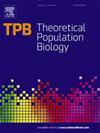Aggregation unveiled: A sequential modelling approach to bark beetle outbreaks
IF 1.3
4区 生物学
Q4 ECOLOGY
引用次数: 0
Abstract
Tree-killing bark beetle infestations are a cause of massive coniferous forest mortality impacting forest ecosystems and the ecosystem services they provide. Models predicting bark beetle outbreaks are crucial for forest management and conservation, necessitating studies of the effect of epidemiological traits on the probability and severity of outbreaks. Due to the aggregation behaviour of beetles and host tree defence, this epidemiological interaction is highly non-linear and outbreak behaviour remains poorly understood, motivating questions about when an outbreak can occur, what determines outbreak severity, and how aggregation behaviour modulates these quantities. Here, we apply the principle of distributed delays to create a novel and mathematically tractable model for beetle aggregation in an epidemiological framework. We derive the critical outbreak threshold for the beetle emergence rate, which is a quantity analogous to the basic reproductive ratio, , for epidemics. Beetle aggregation qualitatively impacts outbreak potential from depending on the emergence rate alone in the absence of aggregation to depending on both emergence rate and initial beetle density when aggregation is required. Finally, we use a stochastic model to confirm that our deterministic model predictions are robust in finite populations.
聚集揭幕:树皮甲虫爆发的连续建模方法。
树木致死性树皮甲虫灾害是针叶林大量死亡的原因之一,对森林生态系统及其提供的生态系统服务造成了影响。预测树皮甲虫爆发的模型对森林管理和保护至关重要,因此有必要研究流行病学特征对爆发概率和严重程度的影响。由于甲虫的聚集行为和寄主树的防御能力,这种流行病学的相互作用是高度非线性的,人们对爆发行为仍然知之甚少。在此,我们运用分布式延迟原理,在流行病学框架内创建了一个新颖、数学上可操作性强的甲虫聚集模型。我们推导出甲虫出现率的临界爆发阈值,该阈值类似于流行病的基本繁殖率 R0。甲虫聚集会对爆发潜力产生定性影响,从没有聚集时仅取决于甲虫出现率,到需要聚集时取决于甲虫出现率和初始甲虫密度。最后,我们使用随机模型来证实我们的确定性模型预测在有限种群中是可靠的。
本文章由计算机程序翻译,如有差异,请以英文原文为准。
求助全文
约1分钟内获得全文
求助全文
来源期刊

Theoretical Population Biology
生物-进化生物学
CiteScore
2.50
自引率
14.30%
发文量
43
审稿时长
6-12 weeks
期刊介绍:
An interdisciplinary journal, Theoretical Population Biology presents articles on theoretical aspects of the biology of populations, particularly in the areas of demography, ecology, epidemiology, evolution, and genetics. Emphasis is on the development of mathematical theory and models that enhance the understanding of biological phenomena.
Articles highlight the motivation and significance of the work for advancing progress in biology, relying on a substantial mathematical effort to obtain biological insight. The journal also presents empirical results and computational and statistical methods directly impinging on theoretical problems in population biology.
 求助内容:
求助内容: 应助结果提醒方式:
应助结果提醒方式:


